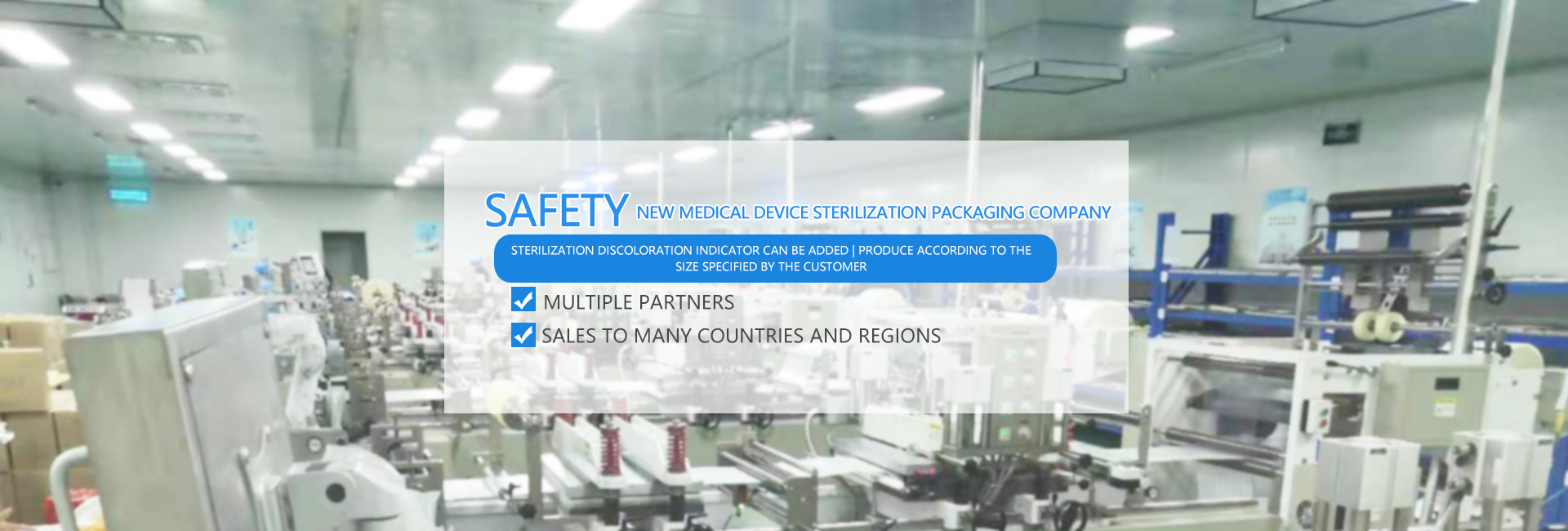01 Requirements for sterilization packaging
Why packaging
After a correct sterilization process, the instruments in the sterilization room should be sterile, but when the instruments are removed from the sterilization room, the outdoor air contains dust particles and microorganisms
If the device is not packaged, it will be contaminated soon
In addition, sterile articles usually need to be stored for a period of time and sent to the department that needs to use them, so the device must be properly packaged to prevent re contamination
Sterilization packaging management requirements
Packaging purpose:
The effect of continuing sterilization shall ensure that sterile instruments and articles can remain sterile before use.
Strict packaging requirements:
The surgical instruments are packed in a closed way, usually with two layers of packaging materials. The closed packaging shall be sealed tightly with special tape.
The weight of the instrument kit shall not exceed 7 kg, and the weight of the dressing kit shall not exceed 5 kg;
The package volume of pre vacuum and pulsating pressure steam sterilizer shall not exceed 30cmx30cmx50cm
The sterilization package shall be clearly marked and traceable; Mark the article name, packer, sterilizer number, sterilization batch, sterilization date, expiration date, etc.
Types of medical packaging materials: storage tanks, textiles (cotton cloth), disposable medical non-woven fabrics, disposable paper plastic packaging, hard packaging containers
Different Packaging Materials - Storage Tanks
Stainless steel storage tanks and tanks, which rely on manual opening and closing before sterilization, cannot be used as sterile barrier systems.
Different packaging materials - cotton cloth
Advantages: good permeability, strong tension resistance, relatively economical
Disadvantages:
Poor microbial barrier performance
In the surgical incision, any foreign object may cause inflammation
Fiber deformation after repeated cleaning
"One for use and one for cleaning" is required
It is difficult to find small holes with naked eye
Indoor air pollution caused by cotton dust release
Short validity period after packaging sterilization
Different packaging materials - medical non-woven packaging
Definition: It is composed of directional or random fibers. It is called cloth because of its appearance and some properties. Disposable fabrics are made of fusion fibers, not thread.
advantage:
No toxic substances
Good hydrophobicity, not easy to cause wet package
Special structure to avoid damage
Storage validity period after sterilization: 6 months
Disadvantages:
It is harder than cotton cloth, and its strength is not as good as cotton cloth
Scope of application: It is used for pressure steam sterilization and ethylene oxide method sterilization. Due to weak tear resistance and thin, it is suitable for sterilization of light and non sharp instruments.
Different packaging materials - disposable paper plastic bag packaging
advantage:
The items in the bag are visible
Good microbial barrier function, good impermeability
Suitable for small and irregular instruments
It can be used for high-pressure steam and ethylene oxide sterilization
Disadvantages:
The paper plastic aseptic bag stored by the clinical department for standby is easy to wrinkle and crack the seal
The dryness is poor when packaging hard objects, and some of them appear on the inner plastic surface
Period of validity: 6 months of detained water droplets
Sharp tools can easily puncture the packaging of paper and plastic bags
Different packaging materials? Hard packaging containers
advantage:
Reusable
Good bacterial barrier
Better device protection
Ensure drying effect
Disadvantages:
Expensive
02. Classification and selection of disinfection and sterilization
High temperature sterilization:
1. Pressure steam sterilization: lower exhaust and pre vacuum pots
2. Dry heat sterilization
Low temperature sterilization:
1. Ethylene oxide sterilization (EO)
2. Hydrogen peroxide plasma sterilization
3. Low temperature formaldehyde sterilization
Classification and selection of sterilization
Sterilization: kill or remove all microorganisms in the environment by physical or chemical methods.
Classification of sterilization methods: steam sterilization, dry heat sterilization and wet heat sterilization;
Chemical gas sterilization: ethylene oxide sterilization, low-temperature plasma sterilization.
Physical or chemical methods shall be used for disinfection and sterilization according to the properties of the articles.
·The physical sterilization method - pressure steam sterilization shall be preferred for sterilization of heat and moisture resistant articles, such as surgical instruments and articles, various puncture needles, etc.
·Chemical sterilization low temperature sterilization method can be selected for heat and moisture resistant articles such as various catheters, precision instruments, artificial grafts, etc., such as ethylene oxide sterilization, hydrogen peroxide plasma sterilization, etc.
·Dry heat sterilization is preferred for oil, powder and paste, such as vaseline gauze.
03. Identification of current chemical indicator cards
Definition and use of sterilization indicating tape
Definition: It is made of crepe paper as the base material, colored ink as the sterilization indicator, and pressure-sensitive adhesive as the back coating. For the indicator tape used for chemical monitoring outside the pressure steam sterilization package, when certain sterilization conditions are reached at 121 ℃, 20 minutes or 132 ℃, 3 minutes, the chemical indicator stripes on the back of the wrinkled paper will change from light yellow to black.
Purpose:
1. It is used to indicate whether the item package has been processed by the pressure steam sterilization process.
2. If the discoloration is uneven or incomplete, it may indicate that the package has not undergone sterilization treatment that meets the conditions.
3. Wrap the package (if no wrapping tape is used).
Definition and use of sterilization sealing label
Definition: It is made of medical wrinkle paper or label paper as the base material, coated with discolored ink as the sterilization indicator, and back coated with pressure-sensitive adhesive. For the indicator tape used for chemical monitoring outside the pressure steam sterilization package, when certain sterilization conditions are reached at 121 ℃, 20 minutes or 132 ℃, 3 minutes, the chemical indicator stripes on the back of the wrinkled paper will change from light yellow to black.
Purpose:
1. It is used to indicate whether the item package has been processed by the pressure steam sterilization process.
2. If the discoloration is uneven or incomplete, it may indicate that the package has not undergone sterilization treatment that meets the conditions.
3. Sterilization information can be recorded (operator, sterilization validity period, name of articles in the bag, pot times, etc.).
Definition and use of indicator card in sterilization package
Definition: It is a rectangular paper structure, printed with thermal dyes, and consists of paperboard, standard color block and indicator color block. Place the pressure steam sterilization indicator card in the center of the item package to be sterilized. After a sterilization cycle (132 ℃, 3min), the color depth of the indicator color block on the card reaches or is deeper than the color of the standard color block, indicating that the temperature reached and the temperature duration have met the conditions required for sterilization; If it is lighter than the standard color block, it indicates that the temperature and temperature duration of the action do not meet the sterilization requirements. Packages that "fail to meet the sterilization requirements" cannot be used and should be re sterilized.
Purpose:
1. It is used to indicate whether the articles (instruments, dressings, etc.) have been processed by the pressure steam sterilization process.
2. If the discoloration is uneven or incomplete, it can be indicated that the article has not undergone sterilization treatment that meets the conditions.
Chemical indicator card for plasma sterilization
Definition: It is a rectangular paper structure, printed with thermal dyes, and consists of paperboard, standard color block and indicator color block. Place the indicator card in the center of the item package to be sterilized. After a sterilization cycle, the color depth of the indicator color block on the card reaches or is deeper than the color of the standard color block, indicating that the conditions required for sterilization have been met; If it is lighter than the standard color block, it indicates that the sterilization requirements are not met. Packages that "fail to meet the sterilization requirements" cannot be used and should be re sterilized.
Purpose:
1. It is used to indicate whether the article has been treated by hydrogen peroxide low-temperature plasma sterilization process.
2. If the discoloration is uneven or incomplete, it can be indicated that the article has not undergone sterilization treatment that meets the conditions.
3. Suitable for low temperature plasma sterilizer.
Chemical monitoring requirements for sterilization quality:
Outside the package: each item to be sterilized needs to use an indicating tape or label outside the package. After a sterilization cycle, observe the color change to indicate whether it has been sterilized;
Inside the bag: use the chemical indicator card, place it at the most difficult position to sterilize, and judge whether it meets the sterilization requirements by observing the change of the color of the chemical indicator.
During the use of sterile articles, what are the prohibited conditions:
Exceeding the specified period of validity;
Loose package or damaged cloth;
The wrapping cloth is wet, with stains, watermarks or water stains;
The indicating tape is not discolored or discolored unevenly;
The sterilizer has stains and rust stains;
Doubt about the sterilization process and quality.
:
:



